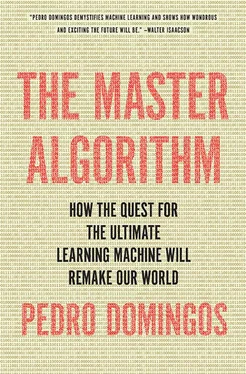Fortunately, something happens in learning that kills off one of the exponentials, leaving only an “ordinary” singly exponential intractable problem. Suppose you have a bag full of concept definitions, each written on a piece of paper, and you take out a random one and see how well it matches the data. A bad definition is no more likely to get, say, all thousand examples in your data right than a coin is likely to come up heads a thousand times in a row. “A chair has four legs and is red or has a seat but no legs” will probably match some but not all chairs you’ve seen and also match some but not all other things. So if a random definition correctly matches a thousand examples, then it’s extremely unlikely to be the wrong definition, or at least it’s pretty close to the real one. And if the definition agrees with a million examples, then it’s practically certain to be the right one. How else would it get all those examples right?
Of course, a real learning algorithm doesn’t just take one random definition from the bag; it tries a whole bunch of them, and they’re not chosen at random. The more definitions it tries, the more likely one of them will match all the examples just by chance. If you do a million runs of a thousand coin flips, it’s practically certain that at least one run will come up all heads, and a million is a fairly small number of hypotheses to consider. For example, that’s roughly the number of possible conjunctive concepts if examples have only thirteen attributes. (Notice you don’t need to explicitly try the concepts one by one; if the best one you found using the conjunctive learner matches all the examples, the effect is the same.)
Bottom line: learning is a race between the amount of data you have and the number of hypotheses you consider. More data exponentially reduces the number of hypotheses that survive, but if you start with a lot of them, you may still have some bad ones left at the end. As a rule of thumb, if the learner only considers an exponential number of hypotheses (for example, all possible conjunctive concepts), then the data’s exponential payoff cancels it and you’re OK, provided you have plenty of examples and not too many attributes. On the other hand, if it considers a doubly exponential number (for example, all possible rule sets), then the data cancels only one of the exponentials and you’re still in trouble. You can even figure out in advance how many examples you’ll need to be pretty sure that the learner’s chosen hypothesis is very close to the true one, provided it fits all the data; in other words, for the hypothesis to be probably approximately correct. Harvard’s Leslie Valiant received the Turing Award, the Nobel Prize of computer science, for inventing this type of analysis, which he describes in his book entitled, appropriately enough, Probably Approximately Correct .
Accuracy you can believe in
In practice, Valiant-style analysis tends to be very pessimistic and to call for more data than you have. So how do you decide whether to believe what a learner tells you? Simple: you don’t believe anything until you’ve verified it on data that the learner didn’t see . If the patterns the learner hypothesized also hold true on new data, you can be pretty confident that they’re real. Otherwise you know the learner overfit. This is just the scientific method applied to machine learning: it’s not enough for a new theory to explain past evidence because it’s easy to concoct a theory that does that; the theory must also make new predictions, and you only accept it after they’ve been experimentally verified. (And even then only provisionally, because future evidence could still falsify it.)
Einstein’s general relativity was only widely accepted once Arthur Eddington empirically confirmed its prediction that the sun bends the light of distant stars. But you don’t need to wait around for new data to arrive to decide whether you can trust your learner. Rather, you take the data you have and randomly divide it into a training set, which you give to the learner, and a test set, which you hide from it and use to verify its accuracy. Accuracy on held-out data is the gold standard in machine learning. You can write a paper about a great new learning algorithm you’ve invented, but if your algorithm is not significantly more accurate than previous ones on held-out data, the paper is not publishable.
Accuracy on previously unseen data is a pretty stringent test; so much so, in fact, that a lot of science fails it. That does not make it useless, because science is not just about prediction; it’s also about explanation and understanding. But ultimately, if your models don’t make accurate predictions on new data, you can’t be sure you’ve truly understood or explained the underlying phenomena. And for machine learning, testing on unseen data is indispensable because it’s the only way to tell whether the learner has overfit or not.
Even test-set accuracy is not foolproof. According to legend, in an early military application a simple learner detected tanks with 100 percent accuracy in both the training set and the test set, each consisting of one hundred images. Amazing-or suspicious? Turns out all the tank images were lighter than the nontank ones, and that’s all the learner was picking up. These days we have larger data sets, but the quality of data collection isn’t necessarily better, so caveat emptor. Hard-nosed empirical evaluation played an important role in the growth of machine learning from a fledgling field into a mature one. Up to the late 1980s, researchers in each tribe mostly believed their own rhetoric, assumed their paradigm was fundamentally better, and communicated little with the other camps. Then symbolists like Ray Mooney and Jude Shavlik started to systematically compare the different algorithms on the same data sets and-surprise, surprise-no clear winner emerged. Today the rivalry continues, but there is much more cross-pollination. Having a common experimental framework and a large repository of data sets maintained by the machine-learning group at the University of California, Irvine, did wonders for progress. And as we’ll see, our best hope of creating a universal learner lies in synthesizing ideas from different paradigms.
Of course, it’s not enough to be able to tell when you’re overfitting; we need to avoid it in the first place. That means stopping short of perfectly fitting the data even if we’re able to. One method is to use statistical significance tests to make sure the patterns we’re seeing are really there. For example, a rule covering three hundred positive examples versus one hundred negatives and a rule covering three positives versus one negative are both 75 percent accurate on the training data, but the first rule is almost certainly better than coin flipping, while the second isn’t, since four flips of an unbiased coin could easily result in three heads. When constructing a rule, if at some point we can’t find any conditions that significantly improve its accuracy then we just stop, even if it still covers some negative examples. This reduces the rule’s training-set accuracy, but probably makes it a more accurate generalization, which is what we really care about.
We’re not home free yet, though. If I try one rule and it’s 75 percent accurate on four hundred examples, I can probably believe it. But if I try a million rules and the best one is 75 percent accurate on four hundred examples, I probably can’t, because that could easily happen by chance. This is the same problem you have when picking a mutual fund. The Clairvoyant Fund just beat the market ten years in a row. Wow, the manager must be a genius. Or not? If you have a thousand funds to choose from, the odds are better than even that one will beat the market ten years in a row, even if they’re all secretly run by dart-throwing monkeys. The scientific literature is also plagued by this problem. Significance tests are the gold standard for deciding whether a research result is publishable, but if several teams look for an effect and only one finds it, chances are it didn’t, even though you’d never guess that from reading their solid-looking paper. One solution would be to also publish negative results, so you’d know about all those failed attempts, but that hasn’t caught on. In machine learning, we can keep track of how many rules we’ve tried and adjust our significance tests accordingly, but then they tend to throw out a lot of good rules along with the bad ones. A better method is to realize that some false hypotheses will inevitably get through, but keep their number under control by rejecting enough low-significance ones, and then test the surviving hypotheses on further data.
Читать дальше












